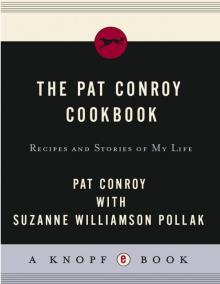- Home
- Pat Conroy
The Pat Conroy Cookbook Page 2
The Pat Conroy Cookbook Read online
Page 2
3. When the mass begins to resemble dough, remove the excess flour. Wash your hands to remove extra flour.
4. Now start to knead the dough. If the dough is too sticky, add a little flour (sparingly). If there is too much flour in the pasta, the dough will dry out, becoming difficult to roll. Using the heels of your hands in an under-and-over motion, knead the dough (rotating it frequently) until it is smooth and elastic, at least 10 minutes.
5. When the dough is smooth and satiny, sprinkle it with a light dusting of flour, cover with a clean dish towel, and let it rest for half an hour. You will need the rest as well because the next step is rolling out the dough.
6. Divide the dough into three sections (or one section for every egg used) to make it more manageable when rolling. Rolling the dough by hand (instead of using a pasta machine) makes pasta that is uniquely yours because you can roll it out to the exact thickness you desire and cut it into the precise width you want.
7. Uncover the dough and knead it a few times. Using a rolling pin (preferably a pin about 20 inches long without handles, for better control), roll across the dough (back and forth) about 6 times; turn the dough 90 degrees and roll back and forth again. You want to stretch the dough to the desired thickness (about ⅛ inch or less).
8. Using a sharp knife, cut the sheet of dough into strips: ⅙ inch wide (tagliarini), ⅛ inch (fettuccine), or ¼ inch (tagliatelle). Drape the noodles over a thin rod (or broom handle) to dry.
If you are serving the pasta immediately, bring a large pot of salted water to a boil and cook the noodles for less than a minute. If you decide to wait (recommended), carefully gather up the noodles and curl them into loose nests, placing them on floured baking sheets. You can let them dry for several hours or freeze for up to 2 weeks. Depending on the thickness of the noodle, the cooking time will be anywhere from 45 seconds to 3 minutes. To test for doneness, snip off the end of a pasta strand and taste.
CHICKEN STOCK It is a rare moment in my life when I open the freezer and don’t find frozen containers of chicken and beef stock. Slow simmering is necessary for a good stock, as well as the occasional skimming of the solids and proteins that bubble to the top. No fanaticism required here, but the clearer the stock, the better the cook. Never, never stir the stock. The making of stock is for poets and philosophers, dreamers and deep thinkers with a dinner party coming up populated only with people you love. • MAKES 4 QUARTS
Two 2½-pound chickens
2 large yellow onions, peeled and halved
3 large carrots, peeled and halved
3 whole celery stalks (with leaves), halved
Sprig of fresh thyme
1 garlic head, unpeeled and cut in half horizontally
1 teaspoon whole black peppercorns
2 teaspoons coarse or kosher salt
1. Remove giblets from the chickens. Under cool, gently running water, rinse chickens inside and out. Pat dry with paper towels.
2. Place all the ingredients in a large stockpot (at least 10 quarts). Add 5 quarts water (completely covering chickens) and bring to a boil. Simmer for 1 hour, occasionally skimming foam from water’s surface with a slotted spoon.
3. Remove the chickens. Let cool slightly, pull the meat off the bones and reserve for another use. Return the chicken bones to the simmering stockpot. Depending on the stock’s use, cook for another hour (a light stock) or up to 5 hours (a richer, deeper stock).
4. Strain the stock through a fine-mesh sieve (or double thickness of cheesecloth) into a large heatproof storage container with a tight-fitting lid. Discard solids. Bring stock to room temperature, cover, and refrigerate overnight. (To freeze, portion the strained stock into smaller containers.)
The stock will keep refrigerated for a week or frozen for several months. (After 8 weeks the stock begins to lose favor.) Always skim the hardened (solid) fat from the surface of the stock before reheating.
FISH STOCK • MAKES ABOUT 1½ QUARTS
2 pounds mild, lean fish and fish trimmings (skeletons,*2 including heads and gills, removed)
1 large carrot, peeled and coarsely chopped
1 yellow onion, peeled and coarsely chopped
1 whole celery stalk (with leaves), coarsely chopped
1 cup dry white wine
1 strip lemon zest or juice of 1 lemon
Small bunch flat leaf parsley
1 teaspoon coarse or kosher salt
1 teaspoon whole black peppercorns
1. Rinse the fish. Place the fish and vegetables in a large stockpot. Add the wine and 2 quarts cold water. Over medium-high heat, bring stock to a simmer. Use a slotted spoon to skim off foam on surface of the liquid. Add the lemon zest, parsley, salt, and peppercorns.
2. Simmer gently for 20 to 30 minutes. Depending on the stock’s use, cook for another hour (a light stock) or up to 5 hours (a richer, deeper stock for gumbo and Creole dishes). Let the stock cool and strain it through a fine-mesh sieve (or double thickness of cheesecloth) into a large heatproof storage container (with a tight-fitting lid). Discard solids. Bring to room temperature, cover, and refrigerate overnight. (To freeze, portion the strained stock into smaller containers.)
The stock will keep refrigerated for a week or frozen for several months. (After 8 weeks the stock begins to lose favor.)
BEEF STOCK • MAKES 3 QUARTS
5 pounds beef bones (with a little meat still attached), cut into 1 -inch pieces by your butcher
2 large yellow onions, peeled and halved
2 carrots, peeled and halved
2 whole celery stalks (with leaves), halved
1 large ripe tomato, halved
5 garlic cloves, unpeeled
1 bay leaf
1 tablespoon whole black peppercorns
1. Preheat the oven to 450°F.
2. Put the bones in a large roasting pan and roast in preheated oven until well browned, about 30 minutes. Add the vegetables and garlic and continue roasting for another 15 minutes (roasting will caramelize the vegetables and beef, resulting in a rich, complex stock).
3. Using long tongs, transfer beef and vegetables to a large stock-pot (about 10 quarts). Add the bay leaf, peppercorns, and 4 quarts cold water (enough to cover the beef by 2 inches).
4. Over medium-high heat, slowly bring the mixture to a boil. Use a slotted spoon to skim foam from the surface of the liquid. Skim the foam frequently, being careful not to actually stir the stock. Simmer gently until the stock is deeply colored, about 5 hours. (You may have to add a little water to keep the meat and vegetables covered.)
5. Strain the stock through a fine-mesh sieve (or double thickness of cheesecloth) into a large heatproof storage container with a tight-fitting lid. Discard solids. Bring stock to room temperature, cover, and refrigerate. (To freeze, portion the strained stock into smaller containers.)
Variation Preheat oven to lowest setting, 200°F or 250°F. After bringing the stock to a boil, place the covered stockpot on the bottom rack (or floor) of the oven. Let stock simmer for 24 to 48 hours. Strain the stock, cool, and refrigerate (as above). The oven variation only applies to beef stock; neither chicken nor fish stock benefits from long simmering.
*1I keep my flour in an airtight bag in the freezer so it is bug-free and always ready to use for pie dough.
*2Do not use strong-tasting fish bones and heads such as mackerel or bluefish unless the stock will be used for a recipe featuring these fish.
The first actual cooking teacher who took both my money and my grief for imparting culinary secrets to me was the inimitable, un-classifiable queen of the Southern kitchen, Nathalie Dupree. Though Nathalie does not know this, she is one of the few people in my life who seems more like a fictional character than a flesh-and-blood person.
When my novel Beach Music came out in 1995, I had included a couple of recipes in the book, and had tried to impart some of my love of Roman cuisine and the restaurants of Rome. Several journalists who write about food for newspapers interviewed me about the food angle in the nov
el, curious about the fact that the book’s protagonist, Jack McCall, wrote cookbooks and restaurant reviews. A woman from the Washington Post conducted a delightful interview over the phone, and during our conversation, I mentioned that I had taken Nathalie’s course in the cooking school she ran in the old Rich’s department store in downtown Atlanta. The woman called Nathalie after our interview, and Nathalie tracked me down to report on the nature of their conversation.
Nathalie’s voice is deep and musical and seductive. She possesses the rare ability to be both maddening and hilarious in the course of a single sentence. Her character is a shifting, ever-changing thing, and she reinvents herself all over again every couple of years. In one way, she seems the same, yet you are aware she is in the process of a complete transformation. When she tells about her life, you could swear she was speaking of a hundred women, not just one.
“Pat, darling,” Nathalie said on the phone, “all my working life I’ve been scheming and plotting and dreaming of ways to get an interview with the food editor of the Washington Post. You can imagine my joy when I heard that the food editor of the Post had left a message on my answering machine. And I thought, Yes, it’s finally happening; your prayers have been answered, Nathalie.”
“That’s great, Nathalie,” I said, not quite knowing where she was going with this. You never know where Nathalie is going with a train of thought; you simply know that the train will not be on time, will carry many passengers, and will eventually collide with a food truck stalled somewhere down the line on damaged tracks.
“Can you imagine my disappointment when I found out that they wanted to interview me about you, instead of about me. I admit, Pat, that after I got over the initial shock, it turned suddenly to bitterness. After all, what do I possibly get out of talking about you when I could be talking about my own cookbooks? Naturally, I did not let on a word about what I was really thinking, but I did suggest, very subtly I might add, that she might want to do a feature on me and my work sometime in the future. When were you in my class, Pat?”
“In 1980,” I said.
“I don’t remember that. Did you really take my class? Who else was in it?”
“My wife Lenore. Jim Landon. George Lanier. A nice woman who lived on the same floor as my dad in the Darlington Apartments.”
“It doesn’t ring a bell for me,” she said. “Was I good?”
“You were wonderful,” I said.
“All my ex-students say that. It must be a gift.”
“You were a great teacher.”
“And sexy. I won’t be happy until you tell me I was also extraordinarily sexy.”
“I could barely cook I was so aroused. All the other men in the class felt the same way. It’s hard to make a perfect soufflé when you’re rutting.”
“Pat, you know the way to a young girl’s heart,” Nathalie said. “But I want you to know that I’ll always be perfectly furious at you for getting into the Washington Post food world before I did. That’s my bailiwick, not yours.”
“It will never happen again, Nathalie,” I promised. “All your bailiwicks will be safe from poor Conroy.”
When Nathalie taught her cooking class at Rich’s, I learned new lessons about insouciance, style, and lack of preparation. Always, at the last minute, Nathalie’s worthy assistant, Kate Almand, would move in to provide a missing utensil or bag of flour or loin of veal that Nathalie had misplaced or left in her car. The joy of watching Nathalie’s cooking shows on television has always come from her artless displays of confusion and disorganization, and her sheer bravado when she actually makes a mistake. Unlike Martha Stewart, Nathalie often looks beaten up when she completes a segment of her show. She can be covered with flour up to her elbows after baking a loaf of bread, can drop her perfectly roasted capon on the kitchen floor, or can garnish her pumpkin pie with cooked rice that she meant to put in her delicious cream of carrot soup. On her television show, Nathalie has turned the culinary mistake or misstep into her signature moment.
Nathalie is always worth the price of admission and I love cooking with her. Disorder follows her around like a spaniel. There is no hum of quiet efficiency in her kitchen to intimidate me as I caramelize the onions or beat the egg whites to a stiff peak. She prides herself on being a hands-on cook, and I have seen her hands dripping with batter, red with blood, and crimson from handling baby beets. Like most good cooks, she is absolutely fearless, taking on each task with gusto. And her conversation mixes well with the mouthwatering aromas rising out of her kitchen as the meal takes shape around us. I personally do not believe Nathalie has ever enjoyed a quiet meal at home with her equally hospitable husband, the writer Jack Bass. When I knew her in Atlanta, the whole city in all its shapes, races, and classes seemed to pass by her dining room table. She attracts friends like a magnet does iron filings. Her desire to entertain and feed people seems insatiable to me, a mark of her character as striking as her beautiful almond-shaped eyes.
On the night our class made a crown roast of pork, orange and fennel salad, turnip greens and grits, and crème brûlée for dessert, she told a story in fits and starts that ended only after she poured the dessert wine. I soon found myself looking forward to Nathalie’s stories as much as I did her recipes. They ranged the world and involved famous chefs, cookbook writers of note, lovers and husbands and boyfriends of both the charming and monstrous varieties. I preferred the stories of her lovers because her voice could turn smoky and catlike as we, her students, chopped and shredded and prepared our meals according to her instructions. The story and the food comingled and exchanged properties.
I can taste neither fennel nor crème brûlée without thinking of the story she told that night. I tell it from memory, but I will try to use Nathalie’s ineffable voice. She could say the word “lover” and infuse it with all the savor and forbiddenness of a Frenchwoman recalling an affair with an Italian count. “I was living in Greenwich Village in New York,” she told us. “I had taken up with a dashing, utterly charming man. He turned out to be a perfect cad, but didn’t they all in those days, darling? Jim, I’d slice that fennel a little thinner. It looks too much like celery when you slice it that way. Yes, perfect. He was, by far, the most sophisticated, demanding lover I had ever been involved with up to that time. He was the consummate gourmet who had eaten in the finest restaurants in the world since he was a child. Well. I decided I was going to cook him a meal that he would never forget, one that would prove my love for him, yet honor his amazing sophistication.
“I went next door to get advice from the two gay men who lived in the most spectacular apartment. They knew everybody and everything, but they were of no help that day. Greenwich Village was astir, at least the gay portion of the Village—no small share, I assure you—with the news of a gay serial killer who would not only murder his poor victims, but would then mutilate them in ghastly ways. My neighbors’ hysteria rendered them useless and I heard them turn all six locks in their door as soon as I left their apartment and began the search for the most unusual meal for my lover.
“There was a little butcher shop in the East Village that sold specialty meats and could usually come up with a surprise. Pat, use a whisk to beat your eggs for the crème brûlée. You’re not scrambling eggs for a country brunch. This is a French dish, dearie. Oh, where was I? Yes. The butcher had a surprise for me. He had two things in his shop he had never carried before: live escargots and testicles freshly cut from yearling calves in upper New York State. ‘Mountain oysters!’ I shouted in triumph, and I was sure that every snail my lover had eaten had come from a can. I paid cash for everything. I spent a fortune. But that’s what you do when you’re in love. You’re never yourself. You are possessed. You’ll do anything. George, you need to get your pork into the oven. Less fanaticism with the presentation. It’s lovely, but it’s still pork. And trichinosis is a fact of life. I took the mountain oysters and snails back to my apartment, then left them in the sink and ran down to buy the wine for the meal. I threw some
ice on the calves’ testicles because organ meat is very perishable. But I got delayed when I asked the French chef who ran a restaurant on my street about the preparation of the escargots. He had a certain dark frisson and I soon realized he was flirting with me. This made me late in my return. My lover would be arriving with roses in a few hours. I opened the door of my apartment and I’ll never forget what I saw there! I’ve had nightmares about it more than once. The snails had conspired to effect a vast breakout. They were everywhere. On the walls, on the ceiling, trailing their slimy bodies across my copper pans, and my cookbooks. My screams of repulsion and terror resounded throughout my apartment building.

 A Lowcountry Heart: Reflections on a Writing Life
A Lowcountry Heart: Reflections on a Writing Life The Death of Santini: The Story of a Father and His Son
The Death of Santini: The Story of a Father and His Son The Boo
The Boo The Prince of Tides
The Prince of Tides Beach Music
Beach Music The Water Is Wide
The Water Is Wide My Losing Season
My Losing Season The Lords of Discipline
The Lords of Discipline Pat Conroy Cookbook
Pat Conroy Cookbook My Reading Life
My Reading Life My Exaggerated Life
My Exaggerated Life The Pat Conroy Cookbook
The Pat Conroy Cookbook A Lowcountry Heart
A Lowcountry Heart The Death of Santini
The Death of Santini